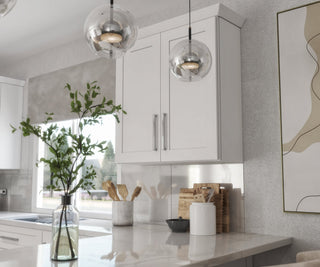When planning for a kitchen remodel or designing an entirely new area, cabinet sizes are significant considerations in terms of functionality and style. Knowing the standard base, wall, and tall cabinet sizes will inform your decisions when making layouts, avoid tight spaces, and achieve a free flow in your kitchen.
Here in this guide, we will be telling you everything that you want to know about the standard kitchen cabinet sizes, i.e., the height, depth, and width — with some hints on how to measure your space properly so you have a correct fit.
Why Cabinet Dimensions Matter
There are industry-standard cabinet sizes to ensure compatibility with appliances, countertops, and ergonomics. Properly sized cabinet maximizes storage space use, keeps your area proportionate aesthetically, and saves you the expense of requiring costly custom adjustments. While RTA kitchen cabinets offers more design freedom, most kitchens take advantage of industry-standard cabinet sizes because they offer the best combination of cost, convenience, and effectiveness.
1. Standard Base Kitchen Cabinet Dimensions
Base cabinets form the basis of all kitchen layouts. They sit on the floor, support the countertops, and in the majority of cases support sinks, dishwashers, or ovens. As they support weight, accuracy while taking these measurements is paramount.
| Feature | Measurement |
| Height (without countertop) | 34.5 inches |
| Height (with countertop) | 35 to 36 inches |
| Depth (without countertop) | 24 inches |
| Depth (with countertop) | 25 to 26 inches |
| Standard Widths | 12", 15", 18", 24", 30", 33", 36", 42", 48" |
1.1 Standard Base Cabinet Height
The standard base cabinet height is 34.5 inches, approximately 36 inches with a countertop installed. That is the most convenient height for most adults and provides a conveniently reached work level for preparing and cleaning up food.
Adjustments can be accommodated — for instance, installing at 38 inches for above-average owners, or 32 inches for accessibility needs.
1.2 Standard Base Cabinet Depth
Standard depth is 24 inches, allowing enough room to fit pots, pans, and under-counter appliances. The countertop itself adds on 1 to 2 inches in depth (up to 25–26 inches), but with a little overhang for comfort as well as beauty.
1.3 Standard Base Cabinet Width
Widths are from 12 to 48 inches, usually in 3-inch increments. Narrow cabinets (12–18 inches) may be used for pull-out spice racks or filler space, and the larger ones (30–48 inches) would fit sinks or storage-needy drawers.
2. Standard Wall Kitchen Cabinet Sizes
Wall cabinets (also referred to as upper cabinets) are mounted above the countertops and provide easy-access storage space for glasses, spices, pantry products, and dishes.
| Feature | Measurement |
| Standard Heights | 12", 15", 18", 24", 30", 36", 42" |
| Standard Depths | 12", 15", 18" |
| Standard Widths | 9" to 36" |
2.1 Standard Wall Cabinet Height
Cabinet height is largely dependent on ceiling height and personal preference. Standard heights are:
-
30-inch cabinets for standard 8-foot ceilings (with room to spare above)
-
36-inch cabinets for 8-foot ceilings without soffits
-
42-inch cabinets for 9-foot ceiling kitchens, skimming the ceiling
Short cabinets (12–24 inches) are often installed over microwaves or refrigerators.
2.2 Standard Wall Cabinet Depth
Standard wall cabinet depth is 12 inches, which is adequate for glasses and plates. Wall cabinets mounted over a refrigerator can be 15–24 inches deep to coordinate with appliance depth.
Choose deeper cabinets carefully — although they offer more storage space, they can become bulky or difficult to access, especially in small kitchens.
2.3 Standard Wall Cabinet Width
Widths are 9 to 36 inches, in 3-inch increments. Bigger cabinets are great for storage of larger items or to use for symmetry alongside range hoods or sinks.
3. Standard Tall Kitchen Cabinet Sizes
Tall cabinets, or pantry or utility cabinets, rise from the floor almost all the way up to the ceiling. They're ideal for taking advantage of vertical space in high-ceilinged kitchens.
| Feature | Measurement |
| Standard Heights | 84", 90", 96" |
| Standard Depths | 12", 24" |
| Standard Widths | 18", 24", 30", 36" |
3.1 Standard Tall Cabinet Height
Tall cabinets are typically available in three heights:
-
84 inches – for 8-foot ceilings with a little space to spare above for molding or trim
-
90 inches – for a snug fit beneath 8-foot ceilings
-
96 inches – for complete floor-to-ceiling tall cabinetry in higher ceilings
3.2 Standard Tall Cabinet Depth
Dry goods-type tall cabinets measure 12 inches deep, or 24 inches deep to store large items like brooms, vacuums, or small appliances.
3.3 Standard Tall Cabinet Width
Standard cabinet heights are 18, 24, and 36 inches. Double ovens, full pantries, or pull-out storage systems will welcome wider tall cabinets.
4. Measuring Your Kitchen for Cabinets
Tape measure is your best friend in cabinet installation. Here's how to begin:
-
Measure all walls: Floor-to-ceiling height, and note any alcoves or jogs in the wall.
-
Mark in place: Note where doors, windows, electrical outlets, plumbing, and HVAC vents are.
-
Measure appliances: Measure the size of your refrigerator, range, dishwasher, and microwave to have space for cabinets and fillers to be the right sizes.
-
Measure ceiling height: This will determine if 30", 36", or 42" wall cabinets are used.
-
Use a kitchen layout grid: Use a bird's eye view with proportional measurements to visualize where cabinet placement will occur.
Tip: Check all critical dimensions and with a cabinetry designer or installer before you order.
Final Thoughts
Knowing standard kitchen cabinet sizes saves you time, money, and aggravation with your remodeling or new-construction project. Standard sizes not only get your kitchen functional and beautiful, but they also make it easy to coordinate cabinets with appliances, countertops, and backsplashes.
Regardless of whether you're working with base, wall, or high cabinets, having an awareness of the standards translates to being able to make smart choices — and maybe even add in some custom touches where it matters.
In choosing to work with RTA cabinets for your remodel, selecting the right size up front will allow you to enjoy a seamless installation and a kitchen that feels hand-crafted just for you.

























